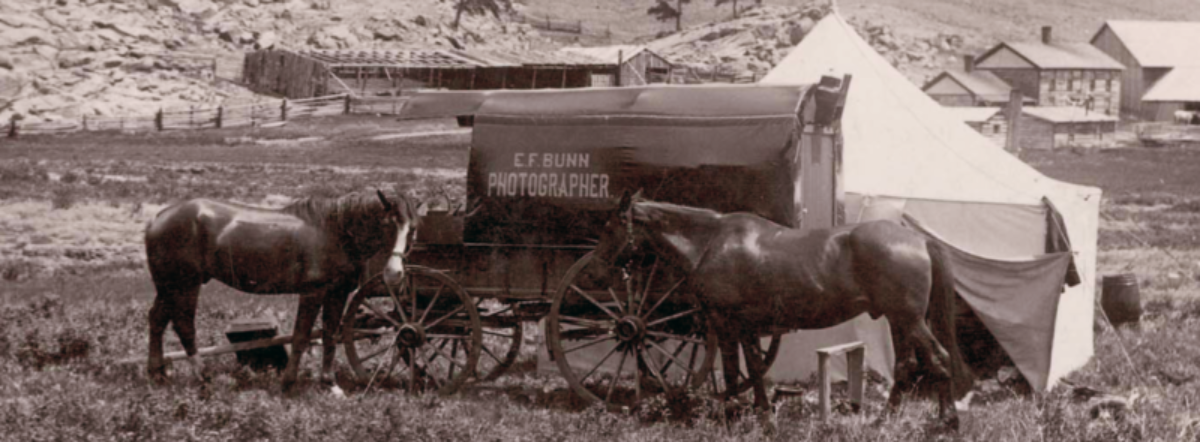
In 1892 or 1893, an unidentified couple arrived at the Central Photo Parlors at the corner of 15th and Lawrence Streets in Denver. They posed for a full-length portrait, likely dressed in wedding attire, in front of a painted backdrop.
In the 19th century, marriage ceremonies were typically held at the home of the bride’s parents. Unlike modern times, it was not common for brides to wear white dresses. Instead, this bride wore a fashionable light-colored dress with a pleated bodice. The skirt was smooth at the hips and featured a wide hem adorned with trim. The narrow sleeves were a popular style in the early 1890s, lacking fullness in the upper arm. Adding to the overall elegance of her attire, a trailing garland of flower blossoms cascaded down her neck and bodice. To complete the look, the bride’s gloves were carefully coordinated with her gown.
The groom wears a dark three-piece suit, a stiff white shirt and a knotted tie with a boutonniere and dark gloves.

They removed their floral accessories and posed for a less formal head-and-shoulders portrait. The close-up, a vignette style, does not show the painted backdrop.
Who operated Central Photo Parlors in Denver? The 1892 and 1893 Denver City Directories place Townsend & Hathaway at the 15th and Lawrence Streets address. The partnership consisted of Israel Lewis Townsend (1839-1921) and Frank Hampton Hathaway (1859-1937). The studio is mentioned in the Rocky Mountain News only a few times in 1893.
Israel L. Townsend was born on July 19, 1839, to Ohio natives, James and Susanna Brown Rodgers Townsend, in Frederickstown, Ohio. His parents were abolitionists, and their Ohio home served as a stop on the Underground Railroad.
I. L. Townsend began his photographic career in 1860. Israel married Mary Jay Yount on October 16, 1861, in Indiana. They had two children, James and Clara. In 1861, his studio was located in Iowa City, Iowa. By 1880, he had moved to Iowa Falls, Iowa, where he produced a series of stereoviews entitled “Iowa Falls and Vicinity.” In the early 1890s, he had relocated to Hastings, Nebraska, but he sold his interest in that studio to his son James.
In 1892, he and Frank Hathaway operated the short-lived studio, Townsend & Hathaway, in Denver, Colorado. Townsend remained in Denver until 1902, usually working as a photographer.
In 1904, Townsend relocated to Pasadena, California, and continued to work as a photographer until at least 1907. He died on December 29, 1921, in Los Angeles, CA, and is buried at Mountain View Cemetery and Mausoleum in Altadena, CA.
Frank H. Hathaway was born on April 3, 1859, in Wyoming, Nebraska, to Moses Hampton Hathaway and Minerva Jane Ross Hathaway. Frank grew up in Nebraska and taught at the Pleasant Ridge School in Cass County. By 1885, he was working as a photographer at various locations in his home state, starting first with a photo car in Fairmont, Nebraska, before setting up a permanent location in Ulysses, Nebraska, where he installed a large skylight and painted and papered the walls.
Hathaway was employed in 1890 by photographer Warren Givens of Seward, Nebraska, because of his proficiency as a retoucher and finisher. They collaborated for a few years before Hathaway relocated to Denver, Colorado, in 1892, where he worked with Israel L. Townsend. After a couple of years with Townsend, Hathaway worked independently in Denver through the late 1890s before returning to Seward, Nebraska.
In 1899, Hathaway, now known for his flash-light photos was back in Seward living and working with Givens. In 1909, Hathaway returned to the Denver area, running a photo studio in Brighton. After a few years, he was employed in the insurance industry. By 1930, he was living in Merced, Colorado, and operating a boarding house. Hathaway passed away on June 4, 1937, in Turlock, California. He was buried at Turlock Memorial Park.
